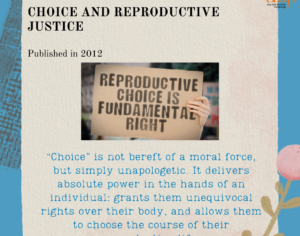Reproductive Rights: One Glove Does Not Fit All – Part 1
Reproductive Justice is powerful on many counts: it links the well-being of individuals to that of their communities; it is a holistic understanding of a person — a vision that matches our experience; it is a bold and inspiring political vision, formulated in terms of what people in all communities need to exercise reproductive freedom.
– Marlene Gerber Fried,
10 Reasons to Rethink Reproductive “Choice”,
Different Takes, Fall 2008
A little before the London Family Planning Summit, Marianne Mollman of Amnesty international wrote an article on Reality Check, questioning the summit’s premise that women in rich countries had everything they needed, while women in poor countries had several unmet needs. Mollman argued that the summit was wrong to assume that a country’s performance in the global market reflected the economic progression of individual women. “To be blunt,” she wrote “wealthy women in poor countries have better access to health care, than poor women in wealthy countries.”
Mollman’s discussion on socioeconomic disparity within a country is relevant to two of Asia’s most populous countries: India and China, which have enjoyed a fact-paced economic growth in recent years. But the unequal distribution of wealth, the persistence of traditional norms, and coercive family planning laws still jeopardize the access to family planning and safe abortions for women in these countries. Characterizing these barriers, and addressing them will help disseminate accurate information to women, and help them exercise their rights to reproductive justice.
Below are short takes on two of these factors. The blog continues tomorrow…
Socioeconomic Disparity:
It is no secret that the recent economic surge has benefitted the middle classes more so than the lower socioeconomic classes.
In India, the lackadaisical implementation of health and family planning laws has limited the number of government hospitals, and health care centers, especially in rural areas to a bare minimum. On the other hand, the economic surge has allowed the private sector to flourish. Safe abortions therefore remain more elusive to poor women in rural areas than to poor women in urban areas, whereas wealthy women in rural areas have the ability to avail of private sector care, as long as other barriers, such as the permission of men, are removed.
Unfortunately, no official data is available on the distribution of health centers in rural and urban China. But the recent large-scale migration of unskilled, and semi-skilled laborers to urban China, and the testimonials of many young girls in books such as Factory Girls, by Leslie Chang, show that girls in urban China, especially those empowered by a job, are able to enjoy more sexual and reproductive freedom than their counterparts in rural areas.
Coercive Family Planning Laws:
China introduced its one-child norm in the 1970s, and has since then implemented it religiously. While families with more than one child, are disqualified from several national benefits, it’s recently come to light that women across the country have been subjected to forced late-term abortions. Conducted only to control the population, these procedures are often not safe, and have led to the death of several women. Journalistic investigations show that women in rural areas and poor women are more likely to be forcefully taken away by government officials than urban, wealthy women.
It’s been 60 years since India first introduced its family planning policy, and 40 years since abortions were made accessible for women on many conditions, except on demand.
 Since the mid-1970s, a two-child norm has been strictly enforced in several parts of the country. This policy was introduced after superficial comparisons with China’s one-child norm, and with the idea that poor women had more children than wealthy women. Therefore in the name of offering “socioeconomic incentives” to the poor, the law disqualifies women with more than two children from applying for bank loans, and from assuming positions of leadership. As Dr. Abhijit Das, director of the CHSJ, pointed out in an interview with ASAP, this coercive law is coupled with a dearth of access to modern contraceptives and safe abortions, and has only subjected several women to a life of penury and dependency.
Since the mid-1970s, a two-child norm has been strictly enforced in several parts of the country. This policy was introduced after superficial comparisons with China’s one-child norm, and with the idea that poor women had more children than wealthy women. Therefore in the name of offering “socioeconomic incentives” to the poor, the law disqualifies women with more than two children from applying for bank loans, and from assuming positions of leadership. As Dr. Abhijit Das, director of the CHSJ, pointed out in an interview with ASAP, this coercive law is coupled with a dearth of access to modern contraceptives and safe abortions, and has only subjected several women to a life of penury and dependency.
Continue to Part 2:
Picture Credit: UNICEF







